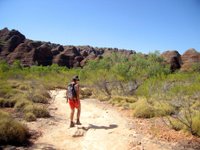

Als we 's morgens al heel vroeg Kununurra uit rijden stoppen we nog even bij de dam voor een fotootje. Er zijn hier veel watervogels actief waaronder ook wat pelikanen.
Het is nog een behoorlijk eind (250 km) rijden naar de Purnululu National Park, oftewel de Bungle Bungles in de volksmond genoemd. 50 Km voor de afslag naar het park stoppen we nog even om te tanken bij Turkey Creek, het enige roadhouse wat we tegenkomen sinds Kununurra.


 Ze hadden ons al vaak gewaar-schuwd voor de zeer slechte weg naar de Bungles. Je moet namelijk 53 km over zeer ruw terrein naar het visitor centre, nou bleek dat allemaal wel mee te vallen. Je kan niet veel harder dan 40 km per uur rijden omdat er veel kuilen en hobbels zijn. De weg is bijna overal bochtig en je rijd over grote hobbels. Sommige heuvels zijn zo hoog en je ziet dus helemaal niet wat er achter zit en waar het pad naartoe gaat of dat er een tegenligger aankomt. Maar we komen heelhuids aan bij het visitor centre van Purnululu NP om vijf voor twaalf.
Ze hadden ons al vaak gewaar-schuwd voor de zeer slechte weg naar de Bungles. Je moet namelijk 53 km over zeer ruw terrein naar het visitor centre, nou bleek dat allemaal wel mee te vallen. Je kan niet veel harder dan 40 km per uur rijden omdat er veel kuilen en hobbels zijn. De weg is bijna overal bochtig en je rijd over grote hobbels. Sommige heuvels zijn zo hoog en je ziet dus helemaal niet wat er achter zit en waar het pad naartoe gaat of dat er een tegenligger aankomt. Maar we komen heelhuids aan bij het visitor centre van Purnululu NP om vijf voor twaalf.  Vijf minuten later en ze waren dicht geweest, het is het einde van het seizoen en er is al een camping gesloten. We worden naar Walardi Campsite, 12 km naar het zuiden, gestuurd en daar vinden we een heel mooi plekje waar we eerst een kopje thee drinken in de schaduw van een boom voordat we het kamp gaan opzetten, deze keer weer voor twee dagen.
Vijf minuten later en ze waren dicht geweest, het is het einde van het seizoen en er is al een camping gesloten. We worden naar Walardi Campsite, 12 km naar het zuiden, gestuurd en daar vinden we een heel mooi plekje waar we eerst een kopje thee drinken in de schaduw van een boom voordat we het kamp gaan opzetten, deze keer weer voor twee dagen. 

We besluiten vanmiddag de Piccaninny Creek te bezoeken, dat is waar al die raar gevormde bergen staan, bijenkorven noemen ze ze ook wel. Dit is ook weer iets van 15 km rijden, maar de wegen binnen het park zijn zelfs iets beter.


 De natuur hier is zo overweldigend dat je soms niet beseft hoe nietig je als klein mensje bent.
De natuur hier is zo overweldigend dat je soms niet beseft hoe nietig je als klein mensje bent. Als een miertje, wat bedrijvig heen en weer loopt over deze aardbol en met schijnbaar als enig doel allerlei kunstmatige technieken te ontwikkelen om het leven aan te passen... aan wat?
Wat zeg ik, met miljarden banjeren we over deze aarde zonder de natuurlijke schoonheid te zien...
 Het effect van de natuur is zo gigantisch groot, zoals deze enorme gaten die uitgesleten zijn door het rivier water wat hier al jaren stroomt in het natte seizoen en met zoveel kracht neerkomt dat het water zich een weg probeert te banen en allerlei draaikolken verzeilt raakt.
Het effect van de natuur is zo gigantisch groot, zoals deze enorme gaten die uitgesleten zijn door het rivier water wat hier al jaren stroomt in het natte seizoen en met zoveel kracht neerkomt dat het water zich een weg probeert te banen en allerlei draaikolken verzeilt raakt. En overal groeit er iets, hoe rotsig, hard of zacht het ook is, een plantje nestelt zich tussen de spleten en groeit.


Wat ik al zei, een nietig klein mensje... Deze foto is gemaakt in de Cathedral Gorge, het eindpunt van de eerste wandeling. Hier is het heerlijk koel en er zit al een groepje wandelaars uit te rusten. Ze barsten spontaan in zingen uit, het is ook een aparte sfeer in deze 'kerk'.


 Daarna staat de Piccaninny Walk op het programma, ook een erg mooie wandeling naar een uitzichtspunt vanaf de hoogte. Je krijgt dan een geweldig uitzicht over de rare rotsen. En mensen die ons nog eens een keer gaan vertellen dat je alleen maar kan genieten vanuit een helicopter omdat je vanaf de grond niets ziet die moeten echt zelf maar eens hun wandelschoenen aantrekken. Vanuit een helicopter is het misschien wel spectaculair (je bent wel 250 $ pp lichter) maar het blijft voor ons een beter gevoel hebben om er IN geweest te zijn. Je een te voelen met al die rotsen en ruimte.
Daarna staat de Piccaninny Walk op het programma, ook een erg mooie wandeling naar een uitzichtspunt vanaf de hoogte. Je krijgt dan een geweldig uitzicht over de rare rotsen. En mensen die ons nog eens een keer gaan vertellen dat je alleen maar kan genieten vanuit een helicopter omdat je vanaf de grond niets ziet die moeten echt zelf maar eens hun wandelschoenen aantrekken. Vanuit een helicopter is het misschien wel spectaculair (je bent wel 250 $ pp lichter) maar het blijft voor ons een beter gevoel hebben om er IN geweest te zijn. Je een te voelen met al die rotsen en ruimte. 

Ik kan het ook niet altijd laten om buiten het begaande pad te treden, wat zit er nou eigenlijk tussen die spleet? Niets dus, maar de klim was leuk, nouja, dat spinifix gras haalt wel heel je benen open...


 Dit vreemde landschap nodigt uit tot rare sprongen...
Dit vreemde landschap nodigt uit tot rare sprongen...De domes, zo worden de bijenkorf vormige rotsen hier genoemd, zijn 360 miljoen jaar geleden ontstaan uit sandstone lagen, de ene laag heeft meer klei dan de andere en dit vormt de rare vormen. De klei-arme laag erodeert ook door het hoge ijzergehalte.
 De middag is voorbij gevlogen en alweer vijf uur als we op ons kamp terugkeren. Het is heerlijk warm wat als nadeel heeft dat de geur van de pit toilet die op een aangename afstand (qua lopen dan) van ons vandaan staat zo nu en dan een zweem van pis met zich meebrengt. Gelukkig niet al te erg, want anders zouden we moeten verkassen.
De middag is voorbij gevlogen en alweer vijf uur als we op ons kamp terugkeren. Het is heerlijk warm wat als nadeel heeft dat de geur van de pit toilet die op een aangename afstand (qua lopen dan) van ons vandaan staat zo nu en dan een zweem van pis met zich meebrengt. Gelukkig niet al te erg, want anders zouden we moeten verkassen.  Inmiddels is het ook al een stukje drukker geworden op het kampeer terrein, toen we aankwamen stond er een tentje, nu is het zo goed als vol. Gelukkig zit je op die bushcamps op gepaste afstand van elkaar en heb je ieder je eigen hoek. We zijn inmiddels wel op onze ruimte gesteld geraakt.
Inmiddels is het ook al een stukje drukker geworden op het kampeer terrein, toen we aankwamen stond er een tentje, nu is het zo goed als vol. Gelukkig zit je op die bushcamps op gepaste afstand van elkaar en heb je ieder je eigen hoek. We zijn inmiddels wel op onze ruimte gesteld geraakt.----------------------------------------------------------------------------------
Purnululu National Park is 110 km north of the town of Halls Creek and 250 km south of Kununurra in the north east of Western Australia. It is an incredible sight, a landscape of beehive-shaped sandstone formations, deep chasms with palm trees and long, deep Piccaninny Gorge with its fan palms adorning the rocks. To appreciate the overall aspect of this weird landscape, one has to take to the air and there are plane and helicopter rides available.
Although of course the Aborigines lived in this region for generations, Purnululu was "discovered" only in the mid-1980s. A television crew came upon the unique beehive-shaped domes in 1982 and in 1987 it was proclaimed a National Park. Geologists tell us that during the Devonian Era, 350 million years ago, a great marine deposit was formed here; it eroded away by the hundreds of millions of wet seasons to the present structure of domes, cliffs and gorges. Rather fragile, the orange bands on the rocks are of silica but the black bands are lichen, overlaying the white sandstone core. There are unique plants here, like a species of Livingstonia palm that has nowhere else been found.
In July 2003, Purnululu National Park and the Bungle Bungle range were declared a World Heritage site.
Of course, to experience the Bungle Bungles properly you have to go on foot and that means first getting there by four wheel drive, as the road to this remote place is 80 km of rough dusty track. The route offers views of boab or baobabs, the weird bottle trees typical of this area and of southern Africa and Madagascar. A hike through this landscape with its sandstone domes is unforgettable. There are breathtaking gorges like Cathedral Gorge and Piccaninny Gorge; the latter is best taken as an overnight walk, 30 km in total, with sleeping in the open. Echidna Chasm is an easier walk, about 2 km, a narrow gorge with walls towering 100 metres and adorned with tall palms. This is one of the most mysterious places of Australia.
----------------------------------------------------------------------------------

Geen opmerkingen:
Een reactie posten